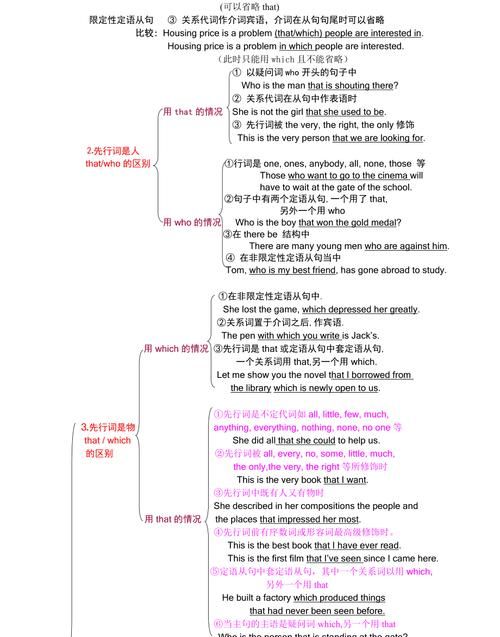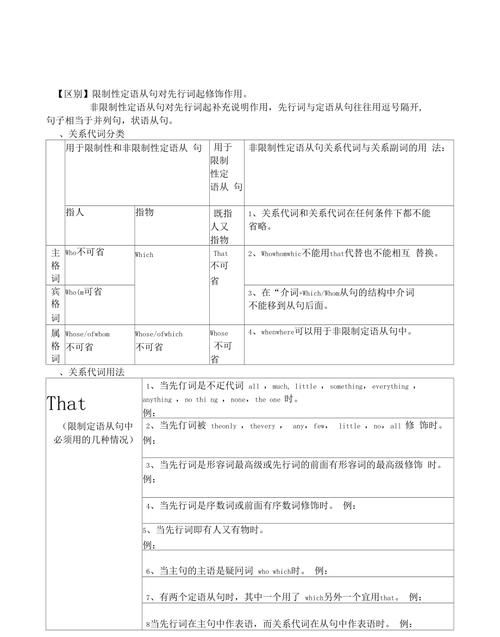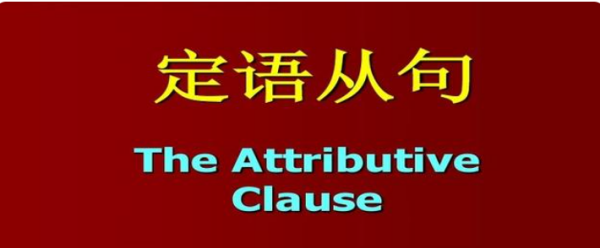本文目录
定语从句语法知识点总结
定语从句(Attributive Clauses)在句中做定语,修饰一个名词或代词,被修饰的名词,词组或代词即先行词。定语从句通常出现在先行词之后,由关系词(关系代词或关系副词)引出。下面就是我给大家带来的定语从句语法知识点汇总,希望大家喜欢!
1 关系代词引导的定语从句
关系代词所代替的先行词是人或物的名词或代词,并在句中充当主语、宾语、定语等成分。关系代词在定语从句中作主语时,从句谓语动词的人称和数要和先行词保持一致。
1)who, whom, that
这些词代替的先行词是人的名词或代词,在从句中所起作用如下:
Is he the man who/that wants to see you?
他就是想见你的人吗?(who/that在从句中作主语)
He is the man whom/ that I saw yesterday.
他就是我昨天见的那个人。(whom/that在从句中作宾语)
2) Whose 用来指人或物,(只用作定语, 若指物,它还可以同of which互换), 例如:
They rushed over to help the man whose car had broken down. 那人车坏了,大家都跑过去帮忙。
Please pass me the book whose (of which) cover is green. 请递给我那本绿皮的书。
3)which, that
它们所代替的先行词是事物的名词或代词,在从句中可作主语、宾语等,例如:
A prosperity which / that had never been seen before appears in the countryside. 农村出现了前所未有的繁荣。(which / that在句中作宾语)
The package (which / that) you are carrying is about to come unwrapped. 你拿的包快散了。(which / that在句中作宾语)
2 关系副词引导的定语从句
关系副词可代替的先行词是时间、地点或理由的名词,在从句中作状语。
1)when, where, why
关系副词when, where, why的含义相当于"介词+ which"结构,因此常常和"介词+ which"结构交替使用,例如:
There are occasions when (on which) one must yield. 任何人都有不得不屈服的时候。
Beijing is the place where (in which) I was born. 北京是我的出生地。
Is this the reason why (for which) he refused our offer? 这就是他拒绝我们帮助他的理由吗?
2)that代替关系副词
that可以用于表示时间、地点、方式、理由的名词后取代when, where, why和"介词+ which"引导的定语从句,在口语中that常被省略,例如:
His father died the year (that / when / in which) he was born. 他父亲在他出生那年逝世了。
He is unlikely to find the place (that / where / in which) he lived forty years ago. 他不大可能找到他四十年前居住过的地方。
3 判断关系代词与关系副词
方法 一: 用关系代词,还是关系副词完全取决于从句中的谓语动词。及物动词后面无宾语,就必须要求用关系代词;而不及物动词则要求用关系副词。例如:
This is the mountain village where I stayed last year.
I'll never forget the days when I worked together with you.
判断改错(注:先显示题,再显示答案,横线;用不同的颜色表示出。)
(错) This is the mountain village where I visited last year.
(错) I will never forget the days when I spent in the countryside.
(对) This is the mountain village (which) I visited last year.
(对) I'll never forget the days (which) I spent in the countryside.
习惯上总把表地点或时间的名词与关系副词 where, when联系在一起。此两题错在关系词的误用上。
方法二: 准确判断先行词在定语从句中的成分(主、谓、宾、定、状),也能正确选择出关系代词/关系副词。
例1. Is this museum ___ you visited a few days age?
A. where B. that C. on which D. the one
例2. Is this the museum ____ the exhibition was held.
A. where B. that C. on which D. the one
答案:例1 D,例2 A
例1变为肯定句: This museum is ___ you visited a few days ago.
例2变为肯定句: This is the museum ___ the exhibition was held.
在句1中,所缺部分为宾语,而where, that, on which都不能起到宾语的作用,只有the one既做了主句的表语,又可做从句的宾语,可以省略关系代词,所以应选D。
而句2中, 主、谓、宾俱全,从句部分为 句子 的状语表地点,既可用副词where,又因 in the museum词组,可用介词in + which 引导地点状语。而此题中,介词on 用的不对,所以选A。
关系词的选择依据在从句中所做的成分,先行词在从句中做主、定、宾语时,选择关系代词 (who, whom, that, which, whose); 先行词在从句中做状语时,应选择关系副词 ( where 地点状语,when 时间状语,why 原因状语) 。
4 限制性和非限制性定语从句
1) 定语从句有限制性和非限制性两种。限制性定语从句是先行词不可缺少的部分,去掉它主句意思往往不明确;非限制性定语从句是先行词的附加说明,去掉了也不会影响主句的意思,它与主句之间通常用逗号分开,例如:
This is the house which we bought last month. 这是我们上个月买的那幢房子。(限制性)
The house, which we bought last month, is very nice.这幢房子很漂亮,是我们上个月买的。(非限制性)
2) 当先行词是专有名词或物主代词和指示代词所修饰时,其后的定语从句通常是非限制性的,例如:
Charles Smith, who was my former teacher, retired last year. 查理·史密斯去年退休了,他曾经是我的老师。
My house, which I bought last year, has got a lovely garden. 我去年买的的那幢房子带着个漂亮的花园。
This novel, which I have read three times, is very touching. 这本小说很动人,我已经读了三遍。
3) 非限制性定语从句还能将整个主句作为先行词, 对其进行修饰, 这时从句谓语动词要用第三人称单数,例如:
He seems not to have grasped what I meant, which greatly upsets me. 他似乎没抓住我的意思,这使我心烦。
Liquid water changes to vapor, which is called evaporation. 液态水变为蒸汽,这就叫做蒸发。
说明:关系代词that和关系副词why不能引导非限制性定语从句。
5 介词+关系词
1)介词后面的关系词不能省略。
2)that前不能有介词。
3) 某些在从句中充当时间,地点或原因状语的"介词+关系词"结构可以同关系副词when 和where 互换。
This is the house in which I lived two years ago.
This is the house where I lived two years ago.
Do you remember the day on which you joined our club?
Do you remember the day when you joined our club?
6 as, which 非限定性定语从句
由as, which 引导的非限定性定语从句,as和which可代整个主句,相当于and this或and that。As一般放在句首,which在句中。
As we know, smoking is harmful to one's health.
The sun heats the earth, which is very important to us.
典型例题
1)Alice received an invitation from her boss, ___came as a surprise.
A. it B. that C. which D. he
答案C. 此为非限定性从句,不能用 that修饰,而用which.,it 和he 都使后句成为句子,两个独立的句子不能单以逗号连接。况且选he句意不通。
2)The weather turned out to be very good, ___ was more than we could expect.
A. what B. which C. that D. it
答案B。which可代替句子,用于非限定性定语从句,而what不可。That 不能用于非限定性定语从句,it不为连词,使由逗号连接的两个句子并在一起在英语语法上行不通。
3)It rained hard yesterday, ____ prevented me from going to the park..
A. that B. which C. as D. it
答案B.
as 和which在引导非限制性定语从句时,这两个关系代词都指主句所表达的整个意思,且在定语从句中都可以作主语和宾语。但不同之处主要有两点:
(1) as 引导的定语从句可置于句首,而which不可。
(2) as 代表前面的整个主句并在从句中作主语时,从句中的谓语必须是系动词;若为行为动词,则从句中的关系代词只能用which.。
在本题中,prevent由于是行为动词,所以正确选项应为B。
As 的用法
例1. the same… as;such…as 中的as 是一种固定结构, 和……一样……。
I have got into the same trouble as he (has).
例2. as可引导非限制性从句,常带有'正如'。
As we know, smoking is harmful to one's health.
As is know, smoking is harmful to one's health.
As是关系代词。例1中的as作know的宾语;例2中,它充当从句的主语,谓语动词know要用被动式。
7 先行词和关系词二合一
1)Whoever spits in public will be punished here.
(Whoever 可以用 anyone who 代替)
2)The parents will use what they have to send their son to technical school.
(what 可以用all that代替)
8 what/whatever;that/what; who/whoever
1)what = the thing which;whatever = anything
What you want has been sent here.
Whatever you want makes no difference to me.
2) who= the person that whoever= anyone who
(错)Who breaks the law will be punished.
(错)Whoever robbed the bank is not clear.
(对)Whoever breaks the law will be punished.
(对)Who robbed the bank is not clear.
3) that 和 what
当that引导定语从句时 ,通常用作关系代词,而引导名词性从句时,是个不充当任何成分的连接词。宾语从句和表语从句中的that常可省略。What只能引导名词性从 句, 用作连接代词,作从句的具体成分,且不能省略。
I think (that) you will like the stamps.
What we need is more practice.
9 关系代词that 的用法
1)不用that的情况
a) 在引导非限定性定语从句时。
(错) The tree, that is four hundred years old, is very famous here.
b) 介词后不能用。
We depend on the land from which we get our food.
We depend on the land that/which we get our food from.
2) 只能用that作为定语从句的关系代词的情况
a) 在there be 句型中,只用that,不用which。
b) 在不定代词,如:anything, nothing, the one, all, much, few, any, little等作先行词时,只用that,不用which。
c) 先行词有the only, the very修饰时,只用that。
d) 先行词为序数词、数词、形容词最高级时,只用that。.
e) 先行词既有人,又有物时。
举例:
All that is needed is a supply of oil.
所需的只是供油问题。
Finally, the thief handed everything that he had stolen to the police.
那贼最终把偷的全部东西交给了警察。
定语从句语法知识点汇总相关 文章 :
1. 中考英语必考语法知识点总结
2. 高考英语定语从句语法知识点与学习方法
3. 初中常考的英语语法知识点汇总
4. 英语高一必修一语法知识点汇总
5. 高中英语定语从句知识
6. 高一英语重点语法英语笔记--定语从句
7. 高中英语语法知识点整理总结
8. 初中英语语法知识点总结
9. 人教版高中英语必修一语法知识点总结


定语从句知识点归纳图
定语从句的相关知识点归纳
1.定语从句:
定语从句是由关系代词或关系副词引导的从句,其作用是作定语修饰主句的某个名词性成分,相当于形容词,所以又称为形容词性从句,一般紧跟在它所修饰的先行词后面。
2.关系词:
引导定语从句的关联词称为关系词,关系词有关系代词和关系副词。关系代词有that, which, who, whom, whose, as等,绝对没有WHAT;关系副词有where, when, why等。关系词常有3个作用:
①连接作用,引导定语从句。
②代替主句中的先行词,甚至可能是主句中的一部分或者整个主句。 ③在定语从句中充当一句子成分。
注:关系代词有主语、宾语之分。一般whom作为宾语。
3.定语:
定语用来限定、修饰名词或代词的,是对名词或代词起修饰、限定作用的词、短语(动词不定式短语、动名词短语和分词短语)或句子,汉语中常用‘……的’表示。主要由形容词担任,此外,名词,代词,数词,分词,副词,不定式以及介词短语也可以来担任,也可以由一个句子来担任。单词作定语时通常放在它所修饰的词之前,作前置定语。短语和从句作定语时则放在所修饰的词之后,作后置定语。
4、先行词:
被定语从句修饰的名词、代词称为先行词。
关系代词引导的定语从句举例
关系代词所代替的先行词是人或物的名词或代词,并在从句中充当主语、宾语、定语等成分。关系代词在定语从句中作主语时,从句谓语动词的人称和数要和先行词保持一致。
1、who, whom, that
这些词代替的先行词是人的名词或代词,who做主语指人,whom作宾语指人,that既可作主语又可作宾语(作宾语可以省略),可以指人也可以指物。在从句中所起作用如下:
(1) Is he the man who/that wants to see you他就是想见你的人吗?(who/that在从句中作主语)
(2) He is the man whom/ that I saw yesterday. 他就是我昨天见的那个人。(whom/that在从句中作宾语)
2、Whose 用来指人或物
(只用作定语, 若指物,它还可以同of which互换,指人的时候也可以用of whom 代替)
(1) They rushed over to help the man whose car had broken down. 那人车坏了,大家都跑过去帮忙。
(2) Please pass me the book whose (of which) color is green. 请递给我那本绿皮的书。
3、 which, that
它们所代替的先行词是事物的名词或代词,在从句中可作主语、宾语等,作宾语时可以省略,例如:
(1) A prosperity which / that had never been seen before appears in the countryside. 农村出现了前所未有的繁荣。(which / that在句中作主语)
(2) The package (which / that) you are carrying is about to come unwrapped. 你拿的包快散了。(which / that在句中作宾语)
4、 as
as 可以做主语,也可以作宾语,作宾语时可以省略,指人或者物。
限定性定语从句
一、关系代词(在句中作主语、宾语或定语)
1. that既可代表事物也可代表人,which代表事物;它们在从句中作主语或宾语,that在从句中作宾语时常可省略关系词,which在从句中作宾语也可以省略。[eg:This is the book (which)you want.]
2而且,如果which在从句中作“不及物动词+介词”的介词的宾语,注意介词不要丢掉,而且介词总是放在关系代词which的前边,但有的则放在它原来的位置
3. 代表物时多用which,但在下列情况中用that而不用which:
a)先行词是anything, everything, nothing , none等不定代词时;
b)先行词由every, any, all, some, no, little, few, much等修饰时,这时的that常被省略;
c)先行词前有序数词或形容词最高级修饰时;
d)先行词就是序数词或最高级时;
e)先行词中既有人又有物时;
f)整个句中前面已有which时;
g)当先行词为物并作表语时。
4. who和whom引导的从句用来修饰人,分别作从句中的主语和宾语,whom作宾语时,要注意它可以作动词的宾语也可以作介词的宾语
5. whose是关系代词,修饰名词作定语,相当于所修饰成分的前置所有格.它引导的从句可以修饰人和物, 当它引导的从句修饰物体时, 可以与 of which 调换,表达的意思一样。
二、关系副词(在句中作状语)
关系副词=介词+关系代词
why=for which
where=in/ at/ on/ ... which (介词同先行词搭配)
when=during/ on/ in/ ... which (介词同先行词搭配)
1. where是关系副词,用来表示地点的.定语从句。
2. when引导定语从句表示时间[注]值得一提的是,表示时间“time"一词的定语从句只用when引导,有时不用任何关系代词,当然也不用that引导。
By the time you arrived in London, we had stayed there for two weeks.
I still remember the first time I met her.
Each time he goes to business trip, he brings a lot of living necessities, such as towels, soap, toothbrush etc。
3. 当从句的逻辑主语是some, any, no, somebody, anybody, nobody, something, anything, everything或nothing时,常用there is来引导
There is somebody here who wants to speak to you. 这里有人要和你说话。
非限定性定语从句
非限定性定语从句的作用是对所修饰的成分作进一步说明,通常是引导词和先行词之间用逗号隔开,将从句拿掉后其他部分仍可成立
1. which引导的非限定性定语从句来说明前面整个句子的情况或主句的某一部分
2.当先行词是专有名词或物主代词和指示代词所修饰时,其后的定语从句通常是非限制性的,例如:
Charles Smith, who was my former teacher, retired last year. 查理·史密斯去年退休了,他曾经是我的老师。
My house, which I bought last year, has got a lovely garden. 我去年买的的那幢房子带着个漂亮的花园。
This novel, which I have read three times, is very touching. 这本小说很动人,我已经读了三遍。
3.非限制性定语从句还能将整个主句作为先行词, 对其进行修饰, 这时从句谓语动词要用第三人称单数,例如:
He seems not to have grasped what I meant, which greatly upsets me. 他似乎没抓住我的意思,这使我心烦。
Liquid water changes to vapor, which is called evaporation. 液态水变为蒸汽,这就叫做蒸发。
4. 有时as也可用作关系代词
5. 在非限定性定语从句中,不能用关系副词why和关系代词that,而用who, whom代表人,用which,whose代表事物,如果需要用why,
可用for which代替.;
p.s: which引导非限定性定语从句其后不可省略成分,as可以
关系代词引导的定语从句
1.who指人在从句中做主语
(1) The boys who are playing football are from Class One. 在踢足球的男孩们是一班的.
(2) Yesterday I helped an old man who lost his way. 昨天,我帮助了一个迷路的老人.
2. whom指人
在定语从句中充当宾语,常省略。(注:who和whom已无太大区别,基本可以通用。唯一区别是who可以做主语而whom不可以。)
(1) Mr. Liu is the person (whom) you talked with on the bus. 刘先生就是在公交车上和你聊天的那个人.
(2) Mr. Ling is just the boy(whom)I want to see. 凌先生恰巧就是我想见的那个男孩.
(3) The man who/whom you met just now is my friend. 你刚刚见到的那个人就是我的朋友.
注意:关系代词whom在口语和非正式语体中常用who代替,可省略。
如果在从句中做宾语,就用whom或who.比如: He is the man whom/who I talk to. 他就是那个和我聊天的男人.
如果是在从句中作主语就只能用who.比如: He is the man who has an English book. 他就是那个有英语书的男人.
3. whose通常指人,也可指物
在定语从句中做定语。
(1) He has a friend whose father is a doctor.
(2) I once lived in a house whose roof has fallen in.whose指物时,常用以下结构来代替
(3) The classroom whose door is broken will soon be repaired.
(4) The classroom the door of which is broken will soon be repaired.
(5) Do you like the book whose color is yellow
(6) Do you like the book the color of which is yellow
4.which指物
在定语从句中做主语或者宾语,做宾语时可省略。
(1) Football is a game which is liked by most boys. 足球是大多数男孩都喜欢的游戏.
(2) This is the pen (which) he bought yesterday. 这是他昨天刚买的钢笔.
5. that指人时
相当于who或者whom;指物时,相当于which。
在定语从句中做主语或者宾语,做宾语时可省略。
(5) The number of the people that/who come to visit the city each year rises one million.
(6) Where is the man that/whom I saw this morning
介词定语从句
一、“介词+关系代词”的用法
当关系代词在定语从句中作介词宾语时,我们通常用“介词+关系代词”引导定语从句。如果指“人”,用“介词+whom”;如果指“物”,用“介词+which”。例如:
Do you know the lady with whom our manager is talking in the office?
Where is the supermarket in which you bought the laptop last week?
使用“介词+关系代词”要注意以下几点:
(一)选用介词的依据:
(1) 根据定语从句中谓语动词的搭配习惯(即固定短语)。例如:
Yesterday we visited the West Lake for which Hangzhou is famous.
(2) 根据先行词的搭配习惯(约定俗成,不一定是短语)。例如:
The old woman with whom you talked just now is a famous artist.
(3) 根据句子的意思来选择。例如:
The naughty boy made a hole in the wall through which he could see what is happening outside.
(4) 表示“所有”关系或“整体中的一部分”时,通常用介词of。例如:
I have about 20 books, half of which were written by Bing Xin, the famous writer.
(二)在定语从句中,含介词的短语动词不可拆开使用(短语拆开后含义发生变化),如look after, look for等。例如:
The babies whom the nurses are looking after are very healthy.(正)
The babies after whom the nurses are looking are very healthy.(误)
(三)“of which / whom”有时可以用“whose+名词”结构来改写。例如:
The building whose roof was damaged in the earthquake has been repaired.
=The building of which the roof was damaged in the earthquake has been repaired.
(四)当先行词为way并且定语从句中缺少状语时,通常用in which或that引导定语从句(in which或that可省略);如果定语从句中不缺少状语,则用关系代词引导(that 或which 可省略)。例如:
All of us disliked the way(in which / that)Tom settled the maths problem.
I don’t understand the way(that/which)the teacher explained to me.
(五)in that不可以引导定语从句,但可以引导原因状语从句。例如:
She didn’t attend the meeting in that / because she was seriously ill.
二、“介词+关系代词”与关系副词的转化
(1)当先行词表示地点,定语从句中缺少地点状语时,通常用关系副词where引导,此时也可选用表示地点的介词+which来代替关系副词where。例如:
I visited the village where many children couldn’t go to school because of poverty.
=I visited the village in which many children couldn’t go to school because of poverty.
(2) 当先行词表示时间,定语从句中缺少时间状语时,通常用关系副词when引导,此时也可选用表示时间的介词+which来代替关系副词when。例如:
We’d better fix a date when we will practice speaking English next week.
=We’d better fix a date on which we will practice speaking English next week.
(3) 当先行词为reason,定语从句中缺少表示原因状语时,通常用关系副词why引导,此时也可以用for which来代替关系副词why。例如:
Can you tell me the reason why you were late for school?
=Can you tell me the reason for which you were late for school?
定语从句的关系词作用
一、定语从句中关系代词的作用和分类
1、关系代词的作用有三个:
(1)连接作用:关系代词引导从句,把从句和主句连接起来;
(2)替代作用:关系代词在从句中替代它前面的先行词;
(3)成分作用:关系代词在从句中总是充当句子成分。
2、关系代词的用法分类
(1)根据所引导的从句的限制性和非限制性; 关系代词的用法与分类有三点依据:
(2)根据所替代的先行词是指人还是指物;
(3)根据它在从句中所充当的成分—主语、宾语、表语或定语。
在宾语从句中,关系代词的作用和分类是基础内容,所以同学们要想学好以后的内容,就必须先掌握好这部分内容。
二、定语从句关系代词有哪些
一 定语从句中关系代词的使用
⒈ 如果修饰人,一般用关系代词who,whom,whose 或that.在定语从句中作主语的一般用who或that,作宾语的一般用whom,who或that,作定语并具有物主性质的用whose.(在定语从句中作宾语的关系代词可省略)
如:
①I don’t like people who/that get angry easily.
我不喜欢容易发脾气的人.
( 关系代词who/ that在定语从句中作主语,不可省略)
②Here is the man (whom/ who/ that) you want to see.
这就是你想见的人.
( 关系代词whom/ who/ that在定语从句中作宾语,可以省略)
③Is there anyone in your class whose home is in the northeast?
你班上有谁家在东北的?
( 关系代词whose在定语从句中作定语,不能省略)
注意:用who 还是whom ,完全根据它们本身在定语从句中的地位和作用而定,与先行词在主句中的作用无关.尤其要注意在带有插入语的定语从句中who和whom的选用.
如:
①The person who sent the letter had to pay the postage.
寄信人要付邮资.
( who sent the letter是定语从句,修饰person,who在定语从句中作主语,因此用主格)
②He is a man who I believe is honest.
他是一个我认为诚实的人.
( I believe是插入语,去掉该插入语剩下的便是He is a man who is honest,在语法及句意上都能成立,who是定语从句中动词is的主语,故用主格,不用宾格whom.)
⒉ 如果修饰事物,用关系代词which 和that,作宾语时可省略.作介词宾语时,如果介词位于关系代词之前,则用which (不能省) ,而不用that(关系代词that既能代人,又能代物).whose也可用来指物(此时可用of which来代替),在定语从句中作定语.
如:
①Don’t buy tomatoes that/ which are green.
不要买颜色还是青的西红柿.
( that/ which 在定语从句中作主语,不能省)
②The fish (that/ which) they sell are not fresh.
他们卖的鱼不新鲜.
( that/ which 在定语从句中作宾语,可以省)
③The classroom whose door is broken will soon be repaired.
= The classroom the door of which is broken will soon be repaired.
门坏了的那个教室将很快修理.
④The tool with which he is working is called a saw.
=The tool (that/ which) he is working is called a saw.
他干活用的那个工具叫叫锯.
(介词with位于关系代词之前,须用which,不能省,也不能用that)
二 定语从句中关系副词的选用
⒈ when指时间,在定语从句中作时间状语,有时也可用介词+which来代替。
如:
I still remember the day when / on which I first came to Beijing.
我还记得我第一次来到北京那天的情景.
She came at a time when we needed her most.
她是在我们需要她的时候来的.
⒉ where指地点,在定语从句中作地点状语,有时也可用介词+which来代替.
如:
That is the house where/ in which he lived ten years ago.
那是他十年前住过的房子.
I have found a peaceful place where/ in which we can study.
我找到了一个能学习的安静的地方.
⒊ why指原因,在定语从句中作原因状语,常可用for+ which来代替.
如:
I know the reason why/ for which she was so angry.
我知道她为什么那么生气.
Do you know the reason why/for which he came so late?
你知道他来得这么晚的原因吗?
◆应注意关系副词和关系代词在定语从句中的不同使用.
如:
I’ll never forget the day when I went abroad myself.
我永远忘不了我独自出国的那一天.
( when在从句中代替时间状语on the day,我们可以把这个句子分解为I’ll never forget the day.I went abroad myself on the day.)
We’ll never forget the days that we spent together.
我们永远也不会忘记我们在一起度过的那些日子.
(that 代替the day,在句中作spent的宾语,that可以省略.该句可分解为We’ll never forget the days.We spent the days together.)
三 way 作先行词之后的定语从句
当“way”表示“方式、方法”在句中作先行词,后被一个定语从句修饰时,引导定语从句可用that ,也可用in which,或什么都不用。
如:
I don’t like the way that he laughed at me.
=I don’t like the way in which he laughed at me.
=I don’t like the way he laughed at me.
我不喜欢他用那种方式来嘲笑我.
四 time 之后的定语从句
time作先行词,前面如有序数词和last修饰时,引导定语从句不能用when,只能用that 或两者都不用.但前面如无序数词或last,常用when(有时也用that)引导定语从句。
如:
This is the last time that I shall give you a lesson.
这是我最后一次给你们上课.
The first time I saw Premier Zhou was in 1958.
我第一次见周总理是在1958年.
I don’t know the exact time when the track and field meet will take place.
我不知道田径运动会举行的确切时间.

英语定语从句知识点总结思维导图
英语定语从句知识点如下:
1、定语从句在句中做定语,修饰一个名词或代词,有时也可以修饰部分或整个句子。2、由which、that引导的从句它们所代替的先行词是事物的名词或代词,在从句中可作主语、宾语等,作宾语时可以省略。
3、非限制性定语从句需使用逗号和主句隔开。

4、whose既可以指人,也可以指物;在从句中作定语,形式为“whose+名词”表所属关系,即谁的。
5、why指原因在定语从句中作原因状语 ,用在reason 后面。
以上就是关于名词性定语从句知识点 ,定语从句语法知识点总结的全部内容,以及名词性定语从句知识点 的相关内容,希望能够帮到您。
